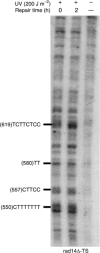Homologous recombination is involved in transcription-coupled repair of UV damage in Saccharomyces cerevisiae
- PMID: 15902273
- PMCID: PMC1142603
- DOI: 10.1038/sj.emboj.7600665
Homologous recombination is involved in transcription-coupled repair of UV damage in Saccharomyces cerevisiae
Abstract
To efficiently protect the integrity of genetic information, transcription is connected to nucleotide excision repair (NER), which allows preferential repair of the transcribed DNA strands (TS). As yet, the molecular basis of this connection remains elusive in eukaryotic cells. Here we show that, in haploids, the RAD26 gene is essential for the preferential repair of the TS during G1. However, in G2/M phase there is an additional RAD51-dependent process that enhances repair of TS. Importantly, the simultaneous deletion of both RAD26 and RAD51 led to complete abolishment of strand-specific repair during G2/M, indicating that these genes act through two independent but complementary subpathways. In diploids, however, RAD51 is involved in repair of the TS even in G1 phase, which unveils the implication of homologous recombination in the preferential repair of the TS. Importantly, the abolishment of NER, by abrogation of RAD1 or RAD14, completely stopped repair of UV damage even during G2/M phase. These results show the existence of functional cross-talk between transcription, homologous recombination and NER.
Figures







Similar articles
-
In UV-irradiated Saccharomyces cerevisiae, overexpression of Swi2/Snf2 family member Rad26 increases transcription-coupled repair and repair of the non-transcribed strand.Mol Microbiol. 2004 Jun;52(6):1653-63. doi: 10.1111/j.1365-2958.2004.04081.x. Mol Microbiol. 2004. PMID: 15186415
-
A postincision-deficient TFIIH causes replication fork breakage and uncovers alternative Rad51- or Pol32-mediated restart mechanisms.Mol Cell. 2010 Mar 12;37(5):690-701. doi: 10.1016/j.molcel.2010.02.008. Mol Cell. 2010. PMID: 20227372
-
A novel role for the budding yeast RAD9 checkpoint gene in DNA damage-dependent transcription.EMBO J. 1996 Aug 1;15(15):3912-22. EMBO J. 1996. PMID: 8670896 Free PMC article.
-
DNA interstrand cross-link repair in Saccharomyces cerevisiae.FEMS Microbiol Rev. 2007 Mar;31(2):109-33. doi: 10.1111/j.1574-6976.2006.00046.x. Epub 2006 Nov 9. FEMS Microbiol Rev. 2007. PMID: 17096663 Review.
-
The role of homologous recombination repair in the formation of chromosome aberrations.Cytogenet Genome Res. 2004;104(1-4):21-7. doi: 10.1159/000077462. Cytogenet Genome Res. 2004. PMID: 15162011 Review.
Cited by
-
Green tea extract promotes DNA repair in a yeast model.Sci Rep. 2019 Mar 7;9(1):3842. doi: 10.1038/s41598-019-39082-9. Sci Rep. 2019. PMID: 30846712 Free PMC article.
-
Rad10 exhibits lesion-dependent genetic requirements for recruitment to DNA double-strand breaks in Saccharomyces cerevisiae.Nucleic Acids Res. 2009 Oct;37(19):6429-38. doi: 10.1093/nar/gkp709. Epub 2009 Sep 3. Nucleic Acids Res. 2009. PMID: 19729509 Free PMC article.
-
In vivo and in silico analysis of PCNA ubiquitylation in the activation of the Post Replication Repair pathway in S. cerevisiae.BMC Syst Biol. 2013 Mar 20;7:24. doi: 10.1186/1752-0509-7-24. BMC Syst Biol. 2013. PMID: 23514624 Free PMC article.
-
The in vivo and in vitro roles of Trypanosoma cruzi Rad51 in the repair of DNA double strand breaks and oxidative lesions.PLoS Negl Trop Dis. 2018 Nov 13;12(11):e0006875. doi: 10.1371/journal.pntd.0006875. eCollection 2018 Nov. PLoS Negl Trop Dis. 2018. PMID: 30422982 Free PMC article.
-
A UV-induced genetic network links the RSC complex to nucleotide excision repair and shows dose-dependent rewiring.Cell Rep. 2013 Dec 26;5(6):1714-24. doi: 10.1016/j.celrep.2013.11.035. Epub 2013 Dec 19. Cell Rep. 2013. PMID: 24360959 Free PMC article.
References
-
- Abbott DW, Thompson ME, Robinson-Benion C, Tomlinson G, Jensen RA, Holt JT (1999) BRCA1 expression restores radiation resistance in BRCA1-defective cancer cells through enhancement of transcription-coupled DNA repair. J Biol Chem 274: 18808–18812 - PubMed
Publication types
MeSH terms
Substances
LinkOut - more resources
Full Text Sources
Molecular Biology Databases
Research Materials

